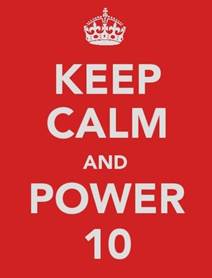What is a Power Ten?
You may have heard the term “Power Ten” in reference to rowing and racing. Specifically, this term is often said by the coxswain to motivate a crew. A “Power Ten” is, traditionally, ten hard strokes of power. The coxswain often will count out each stroke for the crew. Contrary to common belief, the coxswain doesn’t yell “row” with each stroke that the athletes take. (After all, the athletes all are well aware that they are rowing.) More frequently, the coxswain is providing motivation, giving feedback, or executing a race strategy. The coxswain’s first job is steering (and safety), but that responsibility is usually a silent one.
A Power Ten is an all-out effort, but the term is a bit ironic in a race where every stroke should be pulled your hardest. So why does a coxswain call a Power Ten?

Crews are comprised of up to eight different athletes, and the fastest crews row in unison. Variations in the stroke disrupt the boat and thus the speed. A Power Ten helps crews to mentally commit to rowing simultaneously and keep focus. And in reality, it’s hard to maintain 100% effort for the entire race. The coxswain may call a Power Ten to motivate the crew to return to pulling hard when they’ve become tired or to make a move to gain (or pass) on a competitor.
A Power Ten can be a useful tool for rowing indoors as well. Sprinkle Power Tens into your workouts: try breaking up longer workouts like a 5k with a Power Ten every 500m or 1000m. On shorter workouts, Power Tens can help you focus on intervals and sprints. If you’re feeling like you can’t keep up at your same pace any longer, take a Power Ten to dedicate to your best effort.
Power Tens don’t have to be verbal (unless it helps you with your breathing!). Count out each stroke in your head. (Even mentally, I think of each number in a positive and upbeat way.) I usually count each stroke at the catch. As a (very) general rule, ten strokes at full effort will move you approximately 100 meters. Power Tens have become so second nature to me, that I’ll usually find myself counting out the last 10-12 strokes of each workout automatically. I like to finish my workouts strong!
I usually give myself 2-3 strokes to “build” into my Power Tens. This helps me maintain good technique as I start to pull harder. (Note: Power Tens aren’t recommended from a stopped flywheel, as this increases the potential for injury.) I find that once I’ve committed to my Power Ten, my focus, technique, and hence pace all improve.
Why Power Ten? Why not Power Eight, Power Twelve or Power Twenty? My speculation is that it is just a round, convenient number. It’s long enough to help you gain momentum but short enough to demand full exertion. A Power Twenty (and Power Thirty) can (and are) also used by crews, often at the start of a race. Beyond three sets of thirty, however, the effectiveness of counting each stroke usually diminishes.
Once you get the hang of using Power Tens, feel free to use the idea of counting strokes to adjust and improve your rowing. Sometimes, instead of a Power Ten you need a “Focus Ten”, “Ten Strokes for Breathing” or “Ten Strokes for Fast Hands at the finish”. Some athletes will even dedicate their strokes to a person, such as a coach or beloved, or even a cause. (“Ten strokes for fighting melanoma!”) Counting strokes can be an effective way to get the most out of your workouts, either by improving your rowing or finding your motivation.
